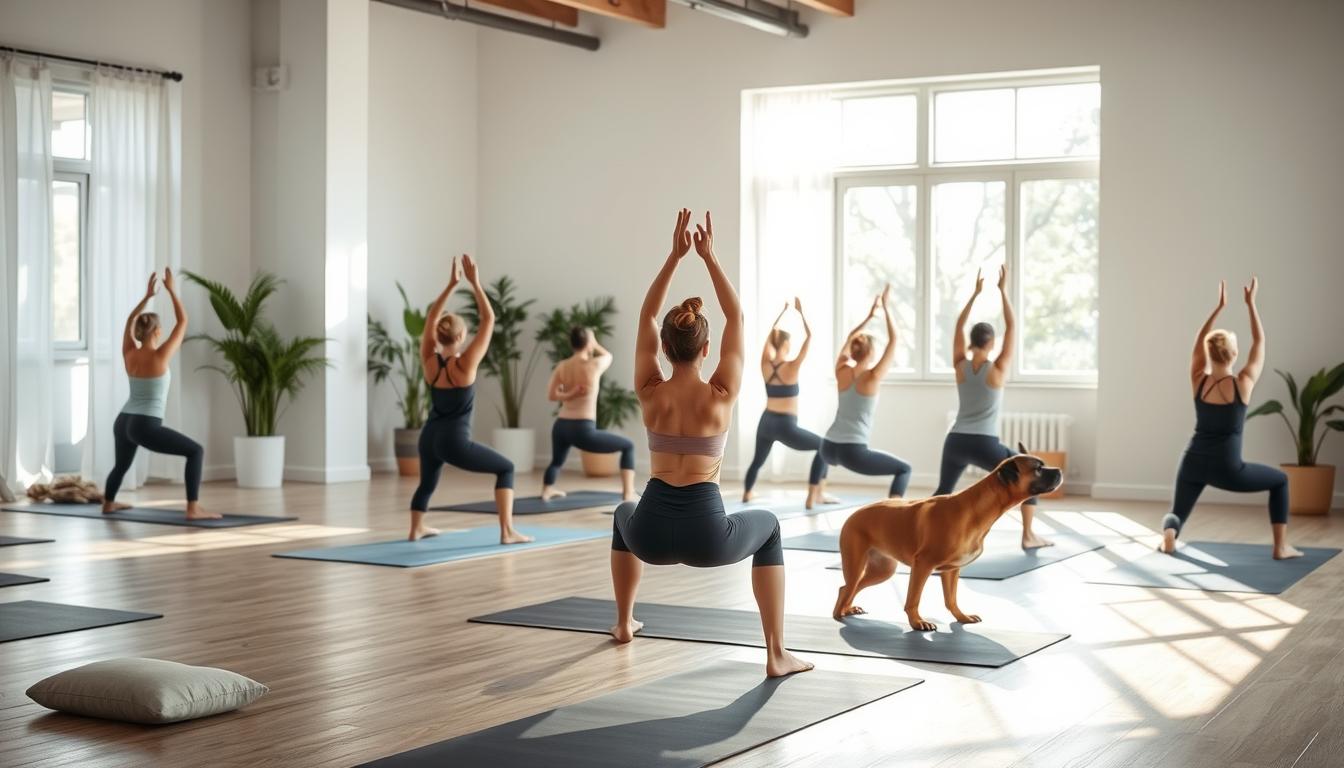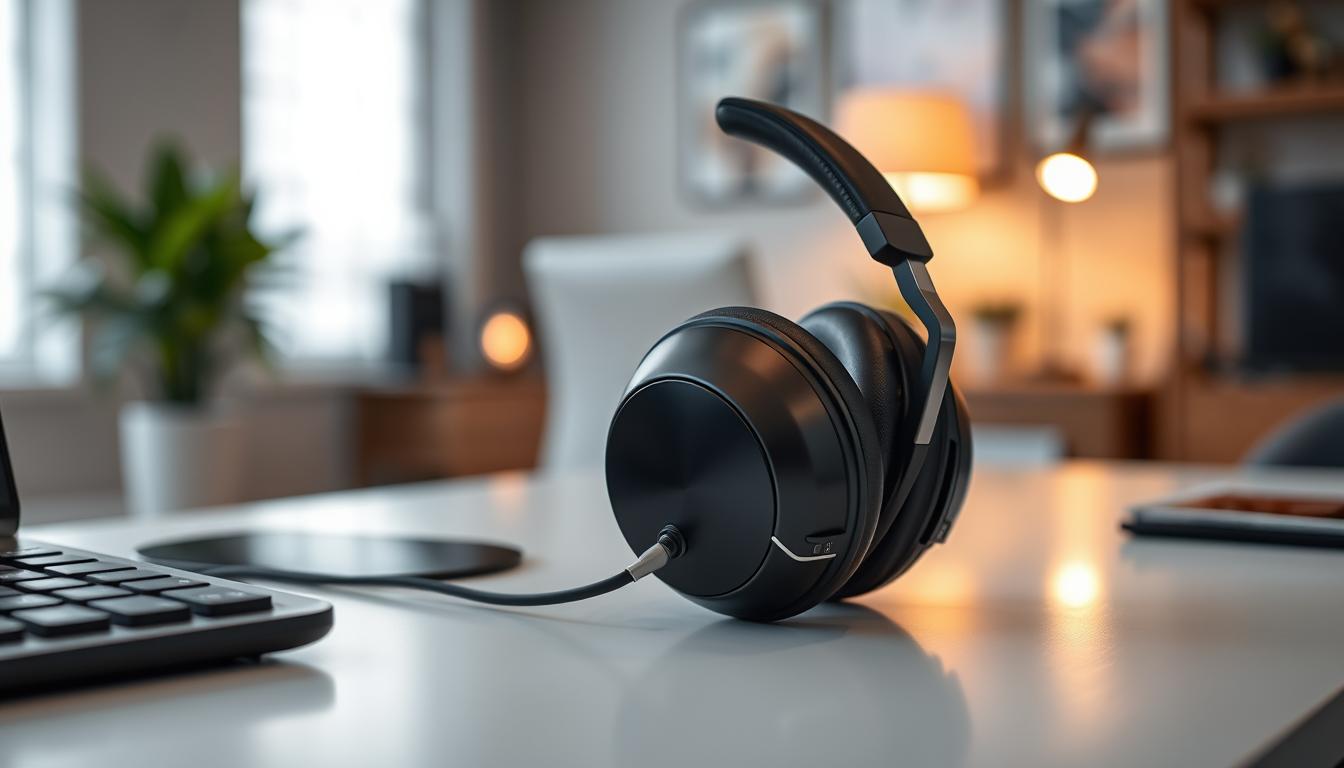
Yoga Poses for Back Pain: Relieve Discomfort Now
In this guide, we'll look at yoga poses and exercises for back pain. These can help improve flexibility and strengthen the spine. Whether it's chronic pain or occasional issues, yoga can offer relief and support your well-being.
Key Takeaways
- Yoga offers a natural and holistic approach to managing back pain
- Specific yoga poses can target and alleviate different types of back pain
- Regular practice of these yoga exercises can improve flexibility, mobility, and core strength
- Incorporating yoga into your routine can be a valuable addition to your overall back pain management plan
- Consult with a healthcare professional or qualified yoga instructor to ensure proper form and safety
Understanding Back Pain and Its Causes
Back pain is a common problem that affects people of all ages. To tackle it with yoga, we need to know the different types of back pain and what causes them. By learning about these, we can make our yoga practice more effective in relieving and managing back pain.
Types of Back Pain
Back pain can occur in various parts of the spine, each with its own reasons and symptoms. The main types include:
- Lower Back Pain: This is pain in the lower back, often from bad posture, muscle strain, or health issues.
- Upper Back Pain: Pain in the upper back, between the shoulder blades, can be from muscle tension, injury, or bad posture.
- Middle Back Pain: Pain in the middle of the spine, sometimes from poor ergonomics or health problems.
Common Causes of Back Pain
Back pain can come from many sources. Some common causes are:
- Poor Posture: Sitting or standing for too long in the wrong way can strain muscles and stress the spine.
- Injury or Trauma: Accidents, falls, or repetitive strain can cause back pain, often from muscle sprains, herniated discs, or other musculoskeletal problems.
- Medical Conditions: Health issues like arthritis, osteoporosis, or spinal stenosis can lead to chronic or recurring back pain.
- Lifestyle Factors: Being overweight, not moving enough, and doing high-impact activities can also contribute to back pain.
Knowing the types of back pain and their causes helps us find effective ways to relieve and manage it with yoga. Next, we'll look at the many benefits of yoga for back pain.
Benefits of Yoga for Back Pain Relief
Yoga is a great way to ease back pain. It uses various poses and techniques to help improve spinal health. This can make you feel better overall.
Yoga boosts flexibility, which is key for back pain relief. It targets muscles and tissues around the spine. This helps increase movement and reduce stiffness.
It also strengthens the core muscles. These muscles support the spine and help maintain good posture. This reduces strain on the lower back and improves spinal alignment.
Yoga is also great for managing stress and tension. It uses deep breathing and meditation to relax muscles and calm the mind. This can help reduce back pain caused by stress.
| Benefits of Yoga for Back Pain | Explanation |
|---|---|
| Increased Flexibility | Yoga poses target the muscles and connective tissues surrounding the spine, gradually increasing range of motion and reducing stiffness. |
| Improved Core Strength | Yoga strengthens the abdominal, back, and hip muscles, enhancing overall core stability and supporting the spine. |
| Stress and Tension Relief | The deep breathing exercises and meditative aspects of yoga can help alleviate muscle tightness and mental stress, which contribute to back pain. |
Adding yoga to your back pain management plan can bring many benefits. You might feel less pain, move better, and feel overall well-being.
"Yoga is a complete system for improving the health of the spine, reducing pain, and restoring flexibility and strength." - Dr. Loren Fishman, Renowned Yoga Therapist
Yoga Poses for Back Pain
Yoga can help ease back pain and boost your health. Start with gentle stretches to warm up your spine. These movements ease discomfort and improve flexibility, making way for more advanced poses.
Gentle Stretches and Warm-ups
Begin with gentle stretches to warm up and loosen your spine. Here are some exercises to get you started:
- Cat-Cow Pose: This simple pose flexes and extends the spine, helping to release tension.
- Child's Pose: A restorative pose that allows the spine to decompress and muscles to relax.
- Seated Forward Fold: A stretch for hamstrings and lower back, adjustable to your flexibility.
- Supine Twist: Lying on your back, gently rock your knees to stimulate spine rotation.
These poses are a good start for back pain relief. Always listen to your body and move at a pace that feels right.
| Yoga Pose | Benefits for Back Pain |
|---|---|
| Cat-Cow Pose | Increases spinal mobility, releases tension in the back |
| Child's Pose | Decompresses the spine, promotes relaxation |
| Seated Forward Fold | Stretches the hamstrings and lower back |
| Supine Twist | Improves spinal rotation and circulation |
Adding these gentle poses to your daily routine prepares your body for more challenging exercises. This sets the stage for a comprehensive and effective yoga practice.
Child's Pose: A Restorative Backbend
The child's pose is a key tool for easing back pain. It's a gentle backbend that offers a calming, restorative experience. It helps release tension in the lower back and promotes spinal relaxation.
This pose is a basic resting pose in yoga. It's known for calming the mind and body. It stretches the spine and opens the hips, providing relief for back pain.
To do the child's pose, start by kneeling on the floor with your knees apart. Then, fold your torso forward, letting your forehead touch the mat. Extend your arms in front of you, palms down, and relax your shoulders. Breathe deeply, feeling your body relax into the floor.
- Start by kneeling on the floor with your knees hip-width apart.
- Fold your torso forward, allowing your forehead to rest on the mat or the floor.
- Extend your arms in front of you, palms facing down, and let your shoulders relax.
- Breathe deeply, feeling the weight of your body melting into the floor.
The child's pose is a restorative backbend that offers comfort and security. It's great for those with back pain. By adding this pose to your yoga practice, you can enjoy the benefits of restorative yoga for back pain and find relief.
"The child's pose is a gentle backbend that can offer a profound sense of relaxation and relief for those dealing with back pain."
Whether you're experienced or new to yoga, the child's pose is a valuable tool for managing back pain. By embracing the child's pose benefits and adding it to your routine, you can work towards a more comfortable, pain-free back.
Cat-Cow Pose: Spinal Mobility and Flexibility
The Cat-Cow Pose is a dynamic yoga sequence that boosts spinal mobility and flexibility. These are key for managing back pain. This gentle movement eases discomfort and promotes spinal health.
Proper Form and Breathing Techniques
To do the Cat-Cow Pose right, focus on proper form and breathing. Here's how:
- Start on your hands and knees, with your wrists under your shoulders and knees under hips.
- Inhale and arch your back, letting your belly drop and lifting your head and tailbone up - this is the Cow Pose.
- Exhale and round your spine, tucking your chin and tailbone and drawing your navel in - this is the Cat Pose.
- Repeat, moving smoothly between poses, breathing with the movement.
Keep your core engaged to support your spine and avoid straining. Breathe deeply and evenly, letting your breath guide the transition.
| Benefit | Description |
|---|---|
| Improved Spinal Mobility | The Cat-Cow Pose's arching and rounding increase spinal flexibility and range of motion. This can ease back pain and improve posture. |
| Enhanced Spinal Awareness | Focusing on the movements and breath in the Cat-Cow Pose improves spinal awareness. This helps you understand and address tightness or discomfort. |
| Stress Reduction | The Cat-Cow Pose's calming nature reduces stress and tension in the body. This can help manage or reduce back pain. |
Adding the Cat-Cow Pose to your yoga routine can improve spinal mobility and flexibility. It also helps with back pain. Always listen to your body and adjust the pose as needed for a safe and comfortable practice.
Downward-Facing Dog: Strengthening and Lengthening
Downward-Facing Dog is a key yoga pose that helps with back pain. It strengthens and stretches the spine, offering support and flexibility. This pose is great for those who need to improve their back health.
To get the most from downward-facing dog for back pain, do it right. Place your hands shoulder-width apart and your feet hip-width apart. Engage your core, lift your hips, and press your heels down. This creates a straight line from head to tailbone.
While in the pose, breathe deeply. This helps the downward-facing dog benefits work their magic. The pose eases lower back pressure and stretches the back muscles, improving mobility.
"Downward-Facing Dog is a game-changer for those dealing with persistent back pain. The pose's ability to strengthen and lengthen the spinal muscles is truly remarkable." - Dr. Sarah Levine, Orthopedic Specialist
If you're new to back pain yoga poses, start slow. Begin with a gentle version and gradually move to the full pose. You can also bend your knees or use a wall for support to make it easier.
Adding Downward-Facing Dog to your yoga routine can help with back pain. It strengthens and stretches the muscles, improving posture and mobility. This pose is a powerful tool for back pain relief.
Yoga poses for back pain
There are many yoga poses that can help with back pain. These poses work on different parts of the spine and muscles. They offer a complete way to ease discomfort.
The Pigeon Pose is great for lower back pain. It opens the hips and releases tension in the glutes and lower back. Start on all fours, then slide one leg forward, crossing the ankle in front of the opposite hip. Slowly lower your torso down, keeping your spine long and your hips squared.
The Reverse Warrior pose is excellent for upper back and shoulder tension. It stretches the front of the body while strengthening the back. From Warrior II stance, reach your top arm up and back, gently arching your spine and opening your chest.
| Yoga Pose | Benefits | How to Perform |
|---|---|---|
| Pigeon Pose | Releases tension in the glutes and lower back | Start on all fours, then slide one leg forward, crossing the ankle in front of the opposite hip. Slowly lower your torso down, keeping your spine long and your hips squared. |
| Reverse Warrior | Stretches the front of the body while strengthening the back | From Warrior II stance, reach your top arm up and back, gently arching your spine and opening your chest. |
Adding these yoga poses to your routine can help you target more muscle groups. This balance of stretching, strengthening, and relaxation can manage your back pain better.
Bridge Pose: Releasing Tension in the Lower Back
The Bridge Pose, or Setu Bandha Sarvangasana, is a gentle yet powerful backbend. It helps ease lower back pain and improves spinal alignment. This pose targets the glutes, hamstrings, and lower back muscles to release tension and boost flexibility.
Modifications and Variations
To do the Bridge Pose, lie on your back with knees bent and feet flat on the floor. Keep your feet hip-width apart. Engage your core and press your feet into the floor to lift your hips off the mat, creating a straight line from your knees to your shoulders. Hold the pose for 5-10 breaths, then slowly lower back down.
If the full Bridge Pose is too challenging, try these modifications:
- Supported Bridge Pose: Place a block or bolster under your sacrum for extra support and lift.
- Bent Knee Bridge Pose: Keep your knees bent and your feet closer to your hips to reduce the range of motion.
- Wall Bridge Pose: Perform the pose with your back against a wall, allowing you to gradually increase the height of the bridge.
For those looking to deepen the pose, try these variations:
- Interlaced Fingers Bridge Pose: Interlace your fingers behind your back and press your palms together to open the chest and shoulders.
- One-Legged Bridge Pose: Lift one leg at a time, keeping the other foot planted, to challenge your balance and stability.
- Wheel Pose: Advance to the Wheel Pose by straightening your arms and lifting your hips even higher, creating a deep backbend.
Always listen to your body and modify the Bridge Pose as needed for a safe and comfortable practice. Adding this backbend to your yoga routine can help ease lower back pain and promote spinal health.
| Pose | Benefits | Modifications |
|---|---|---|
| Bridge Pose |
|
|
"The Bridge Pose is a gentle yet powerful backbend that can help alleviate lower back pain and promote overall spinal health. With various modifications and variations, this pose can be accessible to yogis of all levels."
Seated Spinal Twist: Improving Mobility and Circulation
The seated spinal twist is a gentle yoga pose that helps with back pain. It stretches the back and boosts the nervous system. This makes you feel better overall.
To do the seated spinal twist, sit on the floor with your legs straight out. Bend your right knee and put your right foot on the floor. Twist your upper body to the right, placing your left hand on your right knee and your right hand behind you.
Hold this for a few breaths. You'll feel the stretch in your spine and between your shoulder blades.
The seated spinal twist has many benefits for back pain:
- It makes your spine more flexible, easing stiffness and pain.
- It boosts circulation, bringing more oxygen and nutrients to your back muscles and discs.
- It stimulates your nervous system, helping you relax and reducing stress.
- It gently massages your internal organs, improving digestion and metabolism.
Adding the seated spinal twist to your yoga routine can help with back pain and mobility issues. Always listen to your body and adjust the pose to keep it safe and comfortable.
Corpse Pose: Final Relaxation and Integration
As you end your yoga session, the Corpse Pose, or Savasana, is the ultimate rest. It lets your body and mind relax fully. This posture integrates the benefits of the back pain relief yoga poses you did before.
The corpse pose for back pain means lying flat on your back. Your arms are at your sides with palms up, and your legs are extended. It encourages deep breathing, calming your nervous system and promoting relaxation yoga for back pain.
- Releases tension in the spine and back muscles
- Calms the mind and reduces stress
- Enhances the body's natural healing process
By fully surrendering in Savasana, your body absorbs the benefits of the previous poses. This final pose is key to integrating the practice. It ensures the lasting benefits of your back pain relief yoga session.
"The Corpse Pose is a powerful tool for managing back pain, as it allows the body to deeply relax and the mind to find peace."
See the Corpse Pose as the end of your back pain relief yoga practice. Let your body and mind find the restoration they need. Spend time in this pose, letting go of any discomfort or tension. You'll emerge feeling refreshed and rejuvenated.
| Pose | Benefits | How to Do It |
|---|---|---|
| Corpse Pose (Savasana) |
|
|
Conclusion
Adding yoga to your back pain routine can really help. It can ease discomfort, boost flexibility, and strengthen your spine. By trying out different yoga poses for back pain relief, you can make a practice that fits you.
Always pay attention to how your body feels. Start slow and talk to a doctor if you have health issues. Doing yoga for back pain management regularly can help you take back control of your back health. This way, you can live a more active and pain-free life.
In this guide, we've shown you many yoga poses and techniques for back pain. You've learned about gentle stretches, restorative poses, and poses that strengthen and improve mobility. Now, you have the tools to manage your back pain with yoga. Start using yoga for back pain relief and move towards a healthier, more comfortable life.
FAQ
What are the different types of back pain?
Back pain can be in the lower, upper, or middle back. It's often caused by poor posture, injury, or medical conditions.
What are the common causes of back pain?
Back pain can come from poor posture, injury, or diseases like arthritis. Muscle strain and herniated discs are also common causes.
How can yoga help alleviate back pain?
Yoga can help with back pain by improving flexibility and strength. It also helps maintain good posture and reduces stress.
What are some gentle stretches and warm-up poses for back pain?
For back pain, try Cat-Cow Pose, Child's Pose, and Downward-Facing Dog. These poses prepare your body for more yoga.
How can the Child's Pose provide relief for back pain?
Child's Pose gently stretches the lower back. It helps relax the spine and is great for back pain relief.
What are the benefits of the Cat-Cow Pose for back pain?
Cat-Cow Pose improves spinal mobility and flexibility. It's key for managing back pain. Focus on proper form and breathing.
How can the Downward-Facing Dog Pose help with back pain?
Downward-Facing Dog strengthens and lengthens the spine. It's great for back pain support. Make sure to use proper technique.
What other yoga poses are effective for back pain relief?
Bridge Pose, Seated Spinal Twist, and Corpse Pose also help with back pain. They target different back areas and promote spinal health.
How can the Bridge Pose help release tension in the lower back?
Bridge Pose is a strong backbend that eases lower back tension. It promotes spinal alignment. You can modify it for different skill levels.
What are the benefits of the Seated Spinal Twist for back pain?
Seated Spinal Twist improves spinal mobility and circulation. It's gentle yet effective for back pain. Focus on proper form for best results.
How can the Corpse Pose (Savasana) contribute to back pain relief?
Corpse Pose, or Savasana, is a restful pose. It helps the body and mind relax after yoga. It calms the nervous system and aids in healing back pain.






























